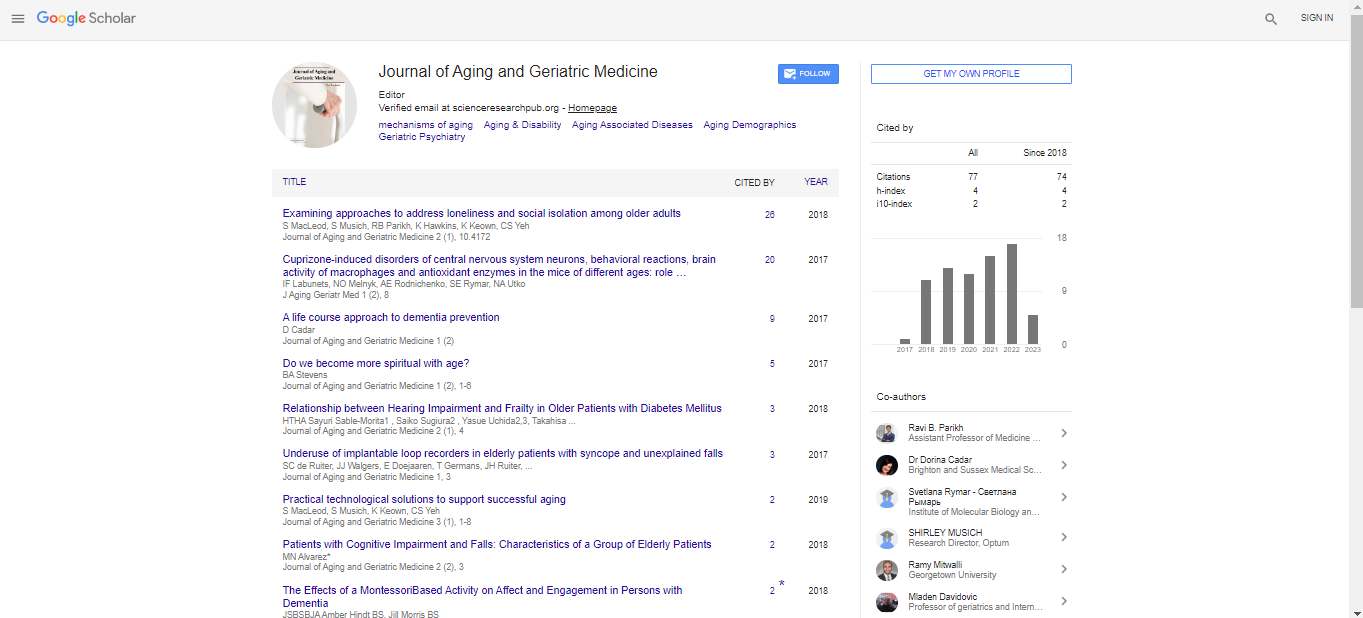Perspective, J Aging Geriatr Med Vol: 6 Issue: 3
Demographics of Aging: A Brief Note
Jacques Legare*
Department of geriatric medicine, University of South Florida, Florida, USA
*Corresponding author: Jacques Legare, Department of geriatric medicine, University of South Florida, Florida, USA
E-mail: Jacques@gmail.com
Received date: 01 March, 2022, Manuscript No. AGM-22-60772;
Editor assigned date: 03 March, 2022, PreQC No. AGM-22-60772 (PQ);
Reviewed date: 17 March, 2022, QC No AGM-22-60772;
Revised date: 22 March, 2022, Manuscript No. AGM-22-60772 (R);
Published date: 29 March, 2022, DOI: 10.4172/ ISSN: 2576-3946.1000133.
Citation: Legare J (2022) Demographics of Aging: A Brief Note. J Aging Geriatr Med 6:3.
Keywords: Epidemiology
Description
Demographic ageing is a recent phenomenon: never before has a civilization become so old, despite the presence of elderly people inside cultures. Because they govern both mortality and fertility, all societies will age; they will be defined by demographic transition and, as a result, demographic ageing. This shift will obviously have demographic and socioeconomic ramifications. Because population ageing is one of civilization's major achievements, it must be experimentally defined and logically analysed in order to be appropriately managed. People are approaching retirement and old age in greater numbers than ever before, and their relative weight in the population will be bigger than ever before. The expense of health care and pensions will rise, as will the method of payment.
Life Course Epidemiology
In many country's elderly population statistical profiles, research interests are especially varied to understand the long-term effects of health behaviour and lifestyle from chronic diseases and lifestyles from chronic diseases and overall. In the past few decades, I saw the proper creation of life course epidemiology as a field of healthy science coherent. The epidemiology of life courses is an adult (genetic), childhood, young age, adolescent, early life of adult life, and a research on long-term impact on the health and health of the generation of hyperphagins. This unique interdisciplinary approach is independent of both risk and protective factors, so it is cumulative, cumulative and interactive, which is responsible for exposure and understanding. The upper goal of the lifetime approach not only provides insight into the fundamental biological, behavioural or psychosocial pathway from the earliest stage of life, but also the public health policy in relation to the best timing It is also affecting. Target prophylactic health strategy throughout your life. Health everywhere is shaped by the same powerful forces. Urbanization and aging demographics are global trends. The epidemiological transition was accompanied by dietary and behavioural changes. Chronic diseases, long thought to be associated with affluent societies, now weigh the most on low- and middle-income countries. In developing countries, the healthcare system, which is still struggling to deal with infectious diseases, must also address the need for long-term care for an increasing number of patients with heart disease, cancer, diabetes, asthma and other chronic illnesses. Prevention is a much better approach, but lifestyle factors that increase the risk of these illnesses go beyond direct public health management. Much of Western applied ethics focuses on medical ethics. But if Robert Butler is right that aging demographics makes our social system obsolete, most other areas of applied ethics are also heavily influenced by social attitudes. Some areas identified in Butler's statement on the rights of the elderly include physical, sexual, emotional and financial abuse. Opportunities for social, cultural and productive roles. Discrimination in the provision of services available to other members of society. Discrimination in obtaining credit and insurance. Selective job discrimination in recruitment, promotion and dismissal. Poverty, abuse, chronic illness, institutionalization and isolation of women. Cultural and economic role. This document urges governments and businesses to evacuate and requires individuals, families and the elderly to stand up for their own rights.
Applied Ethics Agendas
The work of the United Nations Program on Aging and the International Geriatrics and Geriatrics Association project is common for reviewing research priorities of several more prominent global institutions and setting a research agenda for aging in the 21st century. I found a consistent theme that overlaps with the element. Common themes and elements that can be considered an applied ethics agenda include employment and productivity. Economic security; Family relationships / Intergenerational migration; Healthy aging / Health promotion / Biomedical aging; Quality of life / Happiness; Social participation; Access to care systems. And photos and settings.
These agendas are based on the assumption that aging does not "cure", at least in the foreseeable future. Proponents of anti-aging acknowledge that the success of anti-aging projects is "filled with unintended and undesired consequences," but the detailed ethical agenda of the posting society has not yet been developed.
 Spanish
Spanish  Chinese
Chinese  Russian
Russian  German
German  French
French  Japanese
Japanese  Portuguese
Portuguese  Hindi
Hindi 